LAB REPORT
Science and Technology Making Headlines
Dec. 11, 2020

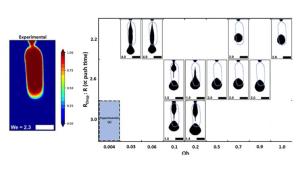
A comparison between the experimentally observed ejected droplet shape at break-up (a) and the simulated droplet shape (b) at various operating conditions approaching the experimental conditions. Image courtesy of Andy Pascall/LLNL.
A drop in the bucket
A team of Lawrence Livermore scientists has simulated the droplet ejection process in an emerging metal 3D printing technique called "Liquid Metal Jetting" (LMJ), a critical aspect to the continued advancement of liquid metal printing technologies.
The team describes the simulating of metal droplets during LMJ, a novel process in which molten droplets of liquid metal are jetted from a nozzle to 3D print a part in layers. The process does not require lasers or metal powder and is more similar to inkjet printing techniques.
"We don't currently have a good understanding of all of the physics that occur right when the droplet breaks off from the metal jet," said co-author and Lab researcher Andy Pascall. "This model points to additional physical mechanisms that might need to be considered to close the gap between experiments and modeling."

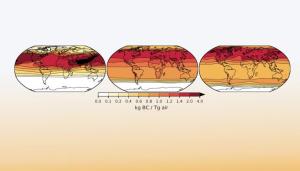
Atmospheric black carbon is shown at one month (left), six months (middle) and 12 months after the nuclear exchange.
Climate consequences of nuclear war
LLNL researchers are using supercomputing to examine the effects that a limited nuclear war might have on climate change.
The researchers examined a scenario involving an exchange of a hundred 15-kiloton nuclear weapons (each roughly the tonnage of the “Little Boy” bomb that was dropped on Hiroshima) between India and Pakistan.
The simulations showed that the smoke from 100 simultaneous firestorms would block sunlight for about four years that in effect would cool the planet. Previous models predicted the sun would be blocked eight to 15 years.
To run the simulations, the researchers first used the Weather Research and Forecasting model to simulate black carbon emissions from the nuclear fires. The results of the WRF model were then plugged into the Energy Exascale Earth System Model, a fully coupled, high-resolution climate system introduced in 2018 with the intent of scaling to forthcoming exascale supercomputers.
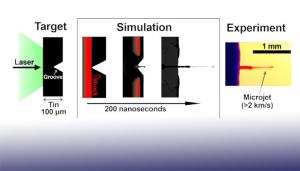
In experiments performed by the MERIT project, lasers shock microscopic tin samples and create microjets that travel at several kilometers per second. Simulations are critical to understand the dynamics of jet formation.
Faster than a speeding bullet
Superman may fly faster than a speeding bullet, but it looks like he may have some competition. When a shock wave travels through material and reaches a free surface, chunks of material can break away and fly off at high speeds. If there are any defects on the surface, the shock forms microjets that travel faster than a speeding bullet.
Understanding how these microjets form and how they interact with material help to improve spacecraft shielding and understanding a planetary impact.
Lawrence Livermore scientists produced hydrodynamic simulations of laser-driven microjetting from micron-scale grooves on a tin surface. From these simulations, they were able to see microjet formation across a range of shock strengths, from drives that leave the target solid after release to drives that induce shock melting in the target.
Simulations are critical in studying microjets as they travel 1-10 kilometers per second (km/s), whereas a bullet travels about 0.3 km/s.

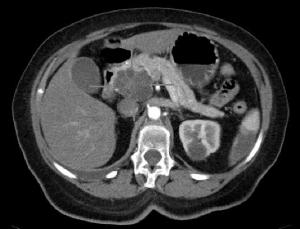
Axial CT image with i.v. contrast. Macrocystic adenocarcinoma of the pancreatic head
Disruptive solution to pancreatic cancer?
Georgetown Lombardi Comprehensive Cancer Center and Lawrence Livermore National Laboratory scientists and collaborators have identified a way to disrupt a process that promotes the growth of pancreatic cancers — one of the most difficult and deadly cancers to treat.
The new findings indicate that the molecule cadherin 11 or CDH11, which is expressed by cancer-associated fibroblasts but is not found in a normal pancreas, stimulated immune tolerance to pancreatic tumors. By removing CDH11, the team found that not only did survival rates increase, but chemotherapy treatment worked much more effectively.
Pancreatic cancer is on course to be the second leading cause of cancer-related deaths in the country, according to the American Cancer Society, with most people surviving less than a year after diagnosis. Therapies approved to treat the cancer are rarely effective and extend survival by only a few months.
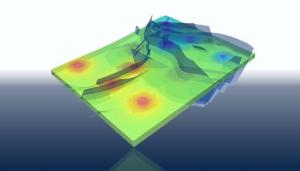
The figure shows a simulation of the fluid pressure distribution in a faulted reservoir due to CO2 injection through multiple wells. Image courtesy of Gulf Coast Carbon Center.
Totally storing carbon dioxide
After more than two years of joint research, Lawrence Livermore, Total and Stanford University have released an open-source, high-performance simulator for large-scale geological carbon dioxide (CO2) storage.
The GEOSX simulator will enable researchers around the world to build on the work of the three partners, providing an open framework to accelerate the development of carbon capture, utilization and storage technologies. It also has application to a variety of other subsurface energy technologies.
The simulator uses field data to predict the behavior and impact of CO2 stored in deep geological repositories. Its resolution and speed were made possible by new technological developments in the fields of algorithmics and high performance computing. It will be used to improve the management and security of geological CO2 repositories and plan for the widespread implementation of these projects at an industrial scale.





